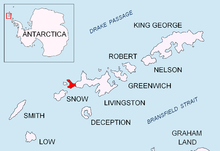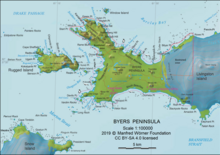Ray Promontory
Appearance
Ray Promontory | |
|---|---|
 Topographic map of Livingston Island | |
| Location | Antarctica |

Start Hill and Dulo Hill in the left background and Penca Hill
in the right background
Ray Promontory is the 7 km long and 2.8 km wide promontory lying between
Start Point and Essex Point. The promontory's interior is mostly occupied by Dospey Heights
.
The feature is part of the Antarctic Specially Protected Area ASPA 126 Byers Peninsula, forming in one of its two restricted zones.[1]
The feature is named after the
American Captain Nathaniel Ray, Master of the sealing
schooner Harmony which operated in the islands in 1820-21 .
Location
The promontory is centered at 62°36′00″S 61°08′40″W / 62.60000°S 61.14444°W (British mapping in 1968, detailed Spanish mapping in 1992, and Bulgarian mapping in 2005 and 2009).
Maps
- Península Byers, Isla Livingston. Mapa topográfico a escala 1:25000. Madrid: Servicio Geográfico del Ejército, 1992. (Map image on p. 55 of the linked study)
- L.L. Ivanov et al. Antarctica: Livingston Island and Greenwich Island, South Shetland Islands. Scale 1:100000 topographic map. Sofia: Antarctic Place-names Commission of Bulgaria, 2005.
- L.L. Ivanov. Antarctica: Livingston Island and Greenwich, Robert, Snow and Smith Islands. Scale 1:120000 topographic map. Troyan: Manfred Wörner Foundation, 2009. ISBN 978-954-92032-6-4
- Antarctic Digital Database (ADD). Scale 1:250000 topographic map of Antarctica. Scientific Committee on Antarctic Research (SCAR). Since 1993, regularly upgraded and updated.
- L.L. Ivanov. ISBN 978-619-90008-3-0
See also
- Rame Bluff, on the southwest side of Ray Promontory
Notes
- ^ Management Plan for Antarctic Specially Protected Area No. 126 Byers Peninsula. Measure 4 (2016), ATCM XXXIX Final Report. Santiago, 2016
References
